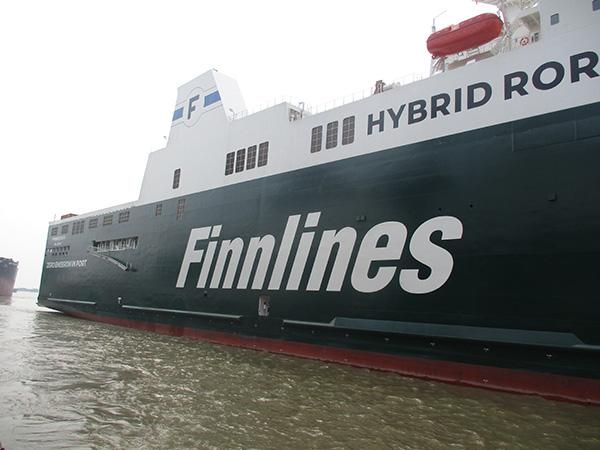Environment
Other
Three hybrid ro-ro vessels ready to fly the finnish flag

M/S ‘Finneco I’ – the first of Finnlines’ three new hybrid ro-ro vessels – was delivered on 28 April 2022 from the Jinling shipyard. The new ship will start operations in June, at first on the Bay of Biscay route between Kotka and Bilbao. The two other hybrid Finneco ships will soon follow as they, too, are ready for delivery to Finnlines in early summer of 2022.
Founded in 1947, the Finnish shipping
company Finnlines Plc. is today part
of the Italian-based Grimaldi Group SpA.
Finnlines has subsidiaries or sales offices in
Germany, Belgium, Great Britain, Sweden,
Denmark, Norway, and Poland. The company
operates ro-ro and passenger services
in the Baltic Sea, the North Sea and the
Bay of Biscay areas.
The three Finneco hybrid ro-ro vessels
currently being delivered are part of a
larger series of twelve hybrid ships ordered
by Grimaldi Group and built by the Jinling
shipyard in China.
”All of those vessels will be largely
similar, except that the six Grimaldi ships
that will operate in the Mediterranean
region are equipped with one additional
deck,” says Mr. Juha Ahia, Naval Architect
and Project Manager, Newbuildings
at Finnlines Plc.

M/S Finneco I will commence operations
on the Bay of Biscay lines, particularly
the cargo route between Kotka in Finland
and Bilbao in Spain.
”The ship is suitable for carrying
versatile ro-ro and project cargo, plus
various other export goods, such as paper
industry products. Return cargo might
typically consist of motor vehicles,” Mr.
Ahia specifies.
The three Finneco ships were
designed by Messrs. Knud E. Hansen
from Denmark. Between themselves, all
three Finnlines’ ships are identical. Knud
E. Hansen also developed the hybrid ro-ro
ship concept that was utilised for the entire
series.

ECO-FRIENDLY PROPULSION
In the design work, one of the key targets
was to make the ships very environmentally-
friendly. The classification society Rina
has assigned an additional class notation
‘Green Plus’ for Finneco I’s environmental
performance.
”Our aim is to make our new ships
more ecological than the vessels of previous
generations. For this purpose, largersized
ships and onboard lithium-ion battery
banks are helpful,” Mr. Ahia notes.
According to him, the Finneco vessels
come with air lubrication in addition to
a state-of-art integrated propeller-rudder
system and modern hull lines that have
been designed for better hydrodynamics.
The vessels are equipped with MAN’s
modern two-stroke main engines having
a lower specific fuel consumption than
four-stroke engines. Consequently, they
will produce less CO2 and other emissions.
The two 12,780 kW engines will yield
a service speed of 20.7 knots.
Complementing the oil-fuelled
engines, the battery banks of 5 MW will
save fuel and reduce emissions.
”The idea is that the lithium-ion batteries
are recharged while the ship is at
sea. At the port, it will not be necessary to
use the ship’s auxiliary engines. This enables
zero-emission operations in port,”
explains Ahia.

REDUCED EMISSIONS
Furthermore, an exhaust gas cleaning
system will cut air emissions and reduce
harmful particles. The Finneco ships will
be equipped with SOx emission control
technology.
Finnlines has invested in eco-friendly
Langh Tec scrubbers to comply with existing
and future SOx emission regulations.
Open loop scrubbers remove SOx from the
exhaust by utilising the natural alkalinity
in seawater.
Seawater is sprayed on the exhaust,
and the SOx in the exhaust reacts with water to form sulphuric acid which is then
neutralised to sulphates by the natural
alkalinity in seawater.
The new ships will be equipped with
waste heat recovery and ballast water
treatment systems.
Also, an innovative air lubrication
system has been designed to reduce hull
resistance. Compressors and nozzles at
the ship’s bow will produce an air buffer
beneath the specially-designed hull, resulting
in reduced resistance and thus reduced
fuel consumption.
Additionally, the vessels will be
equipped with approximately 600 square
metres of solar panels. Renewable energy
is available on board to users.

LARGE-SIZED RO-RO SHIPS
After Finneco I, the other ships in the series
– Finneco II and III – will be delivered during
the summer of 2022.
”We chose the Jinling shipyard as
shipbuilders since we knew them to be
capable and competent for producing
ro-ro vessels. As early as in 2007, the same
shipyard started the project to build M/S
Finnbreeze and her sister ships’ project for
Finnlines,” recounts Ahia.
The Finneco ro-ro vessels are 238
metres in length, with a cargo capacity
of 5,800 lane metres. One vessel is able
to carry e.g. approximately 300 trailers,
150 cars and 500 sea containers for each
sailing.
The ships are considerably larger than
previous-generation ro-ro vessels. Compared
with the largest vessels in today’s
Finnlines fleet, the cargo carrying capacity
of the hybrid newbuilds will increase
by nearly 40 percent. According to Finnlines,
the new ships will be larger and more
eco-friendly than any ro-ro vessel currently
operating in the Baltic Sea.
FLEXIBLE CARGO OPERATIONS
As lorry drivers will be frequent passengers
aboard the ro-ro ships, Finnlines will
upgrade the services and accommodation
on these freight ships. The ships will
include a gym and sauna area, dining and
recreation room, and laundry facilities for
all drivers to use. To enhance comfort on
board, drivers will be allocated single cabins.
There will be 12 cabins for drivers and
26 cabins for the crew on each Finneco
ship.
The new ships are designed to be
flexible for all type of ro-ro cargo. Efficient
cargo operations will be ensured
by arrangement of stern ramps, internal
ramps, and hoistable car decks. Certain
areas on cargo decks have been dedicated
for loading of paper reels.
Several decks and internal ramps
speed up loading and unloading.
“At the same the vessels will be quite
flexible – hoistable decks make it possible
to utilise the cargo space efficiently for
new cars, and the high clearance on main
deck for any type of rolling freight up to 7
metres,” Mr. Ahia points out.
by Ari Mononen
pictures by Finnlines



